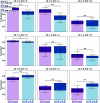Providing context: Extracting non-linear and dynamic temporal motifs from brain activity
- PMID: 40504803
- PMCID: PMC12161560
- DOI: 10.1371/journal.pone.0324066
Providing context: Extracting non-linear and dynamic temporal motifs from brain activity
Abstract
Approaches studying the dynamics of resting-state functional magnetic resonance imaging (rs-fMRI) activity often focus on time-resolved functional connectivity (tr-FC). While many tr-FC approaches have been proposed, most are linear approaches, e.g. computing the linear correlation at a timestep or within a window. In this work, we propose to use a generative non-linear deep learning model, a disentangled variational autoencoder (DSVAE), that factorizes out window-specific (context) information from timestep-specific (local) information. This has the advantage of allowing our model to capture differences at multiple temporal scales. We find that by separating out temporal scales our model's window-specific embeddings, or as we refer to them, context embeddings, more accurately separate windows from schizophrenia patients and control subjects than baseline models and the standard tr-FC approach in a low-dimensional space. Moreover, we find that for individuals with schizophrenia, our model's context embedding space is significantly correlated with both age and symptom severity. Interestingly, patients appear to spend more time in three clusters, one closer to controls which shows increased visual-sensorimotor, cerebellar-subcortical, and reduced cerebellar-visual functional network connectivity (FNC), an intermediate station showing increased subcortical-sensorimotor FNC, and one that shows decreased visual-sensorimotor, decreased subcortical-sensorimotor, and increased visual-subcortical domains. We verify that our model captures features that are complementary to - but not the same as - standard tr-FC features. Our model can thus help broaden the neuroimaging toolset in analyzing fMRI dynamics and shows potential as an approach for finding psychiatric links that are more sensitive to individual and group characteristics.
Copyright: © 2025 Geenjaar et al. This is an open access article distributed under the terms of the Creative Commons Attribution License, which permits unrestricted use, distribution, and reproduction in any medium, provided the original author and source are credited.
Conflict of interest statement
The authors have declared that no competing interests exist.
Figures





Update of
-
Providing context: Extracting non-linear and dynamic temporal motifs from brain activity.bioRxiv [Preprint]. 2024 Jun 27:2024.06.27.600937. doi: 10.1101/2024.06.27.600937. bioRxiv. 2024. Update in: PLoS One. 2025 Jun 12;20(6):e0324066. doi: 10.1371/journal.pone.0324066. PMID: 38979316 Free PMC article. Updated. Preprint.
Similar articles
-
Providing context: Extracting non-linear and dynamic temporal motifs from brain activity.bioRxiv [Preprint]. 2024 Jun 27:2024.06.27.600937. doi: 10.1101/2024.06.27.600937. bioRxiv. 2024. Update in: PLoS One. 2025 Jun 12;20(6):e0324066. doi: 10.1371/journal.pone.0324066. PMID: 38979316 Free PMC article. Updated. Preprint.
-
A method for estimating and characterizing explicitly nonlinear dynamic functional network connectivity in resting-state fMRI data.J Neurosci Methods. 2023 Apr 1;389:109794. doi: 10.1016/j.jneumeth.2023.109794. Epub 2023 Jan 15. J Neurosci Methods. 2023. PMID: 36652974
-
Nonlinear functional network connectivity in resting functional magnetic resonance imaging data.Hum Brain Mapp. 2022 Oct 15;43(15):4556-4566. doi: 10.1002/hbm.25972. Epub 2022 Jun 28. Hum Brain Mapp. 2022. PMID: 35762454 Free PMC article.
-
A confounder controlled machine learning approach: Group analysis and classification of schizophrenia and Alzheimer's disease using resting-state functional network connectivity.PLoS One. 2024 May 20;19(5):e0293053. doi: 10.1371/journal.pone.0293053. eCollection 2024. PLoS One. 2024. PMID: 38768123 Free PMC article.
-
Resting-state functional connectivity in treatment response and resistance in schizophrenia: A systematic review.Schizophr Res. 2019 Sep;211:10-20. doi: 10.1016/j.schres.2019.07.020. Epub 2019 Jul 19. Schizophr Res. 2019. PMID: 31331784
References
-
- Yingzhen L, Mandt S. Disentangled sequential autoencoder. In: Proceedings of the International Conference on Machine Learning. PMLR; 2018, pp. 5670–9.
-
- Tonekaboni S, Li C, Arik S, Goldenberg A, Pfister T. Decoupling local and global representations of time series. In: Proceedings of the International Conference on Artificial Intelligence and Statistics. PMLR; 2022, pp. 8700–14.
MeSH terms
Grants and funding
LinkOut - more resources
Full Text Sources
Medical

